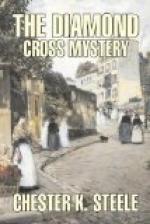Mrs. Darcy, who was sixty-five years of age, had carried on the jewelry business of her husband, Mortimer Darcy, after his death, which preceded her more tragic one by about seven years. Mortimer Darcy had been a diamond salesman for a large New York house in his younger days, and had come to be an expert in precious stones. Many good wishes, and not a little trade, had gone to him from his former employers, and some of their customers bought of him when he went into business for himself in the thriving city of Colchester.
Knowing that to start anew in a strange town would mean uphill work for him and his wife, Mortimer Darcy had awaited an opportunity to buy the business of a man whom he had known for a number of years and to whom he had sold many diamonds and other stones. This man—Harrison Van Doren by name—had what was termed the best jewelry trade in Colchester. The “old” families—not that any of them could trace their ancestry back very far—liked to say that “we get all our stuff at Van Doren’s.”
This name, on little white plush-lined boxes, containing pins or sparkling rings, came to mean almost as much as some of the more expensive names in New York. Young ladies counted it a point in the favor of their lovers if the engagement circlet came from Van Doren’s. And Mortimer Darcy, knowing the value of that class of trade, had, when he purchased Mr. Van Doren’s business fostered that spirit. Mrs. Darcy, on the death of her husband, had further catered to it, so that the Darcy establishment, though it was not the richest or most showy in Colchester, was safely counted the most exclusive—that is, it had a full line of the best goods, be it clocks or diamonds, and it had what, in bygone days, was called a “carriage trade,” but which is now referred to as “automobile.”
That is to say, those, aside from a casual trade with people who dropped in as they might have done to a grocery, to get what they really needed in the way of jewelry, came in gasolene or electric cars where their ancestors had come with horses and carriage.
So Darcy’s jewelry store was known, and though a bit old-fashioned in a way, was favorably known, not only to the older members of the rich families of the place, but to the younger set as well. The pretty girls and their well-groomed companions of the “Assembly Ball” set liked to stop in there for their rings, brooches, scarf pins or cuff links, and very frequent were the rather languid orders:
“You may send it, charge.”
It was to that class of trade that Mrs. Darcy catered. She understood it, and it understood her. That was enough. She took a personal interest in the business to the extent of being in the store almost every day, as her husband had been before her, to advise and be available for consultation, whether it was the buying of a gold teething ring for the newest member of the family, an engagement ring for the latest debutante, a watch for “son,” attaining his majority, or perhaps new gold glasses for grandpapa or grandmama.




